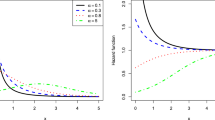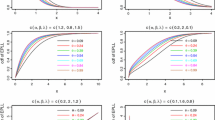Abstract
In this work, some characterizations of the geometric distribution based on two kinds of residual lifetime are presented. Firstly we characterize geometric distribution by using certain relationships of moments of the truncated life from below, that is \(\max \{X-t,0\}\), where X is a positive integer-valued random variable. Secondly using certain relationships of moments of residual life \(\gamma _{t}\) at t of a renewal process, we characterize the common distribution of the inter-arrival times \( \{X_{i},i\ge 1\}\) to be geometrically distributed when \(X_{1}\) is also a positive integer-valued random variable.
Similar content being viewed by others
References
Chong KM (1977) On characterizations of the exponential and geometric distributions by expectations. J Am Stat Assoc 72(357):160–161
Çinlar E, Jagers P (1973) Two mean values which characterize the poisson process. J Appl Probab 10:678–681
Dallas AC (1979) On the exponential law. Metrika 26(1):105–108
Denuit M, Dhaene J, Goovaerts M, Kaas R (2006) Actuarial theory for dependent risks: measures, orders and models. John Wiley & Sons, New York
Gupta PL, Gupta RC (1986) A characterization of the poisson process. J Appl Probab 23:233–235
Gupta RC (2006) Variance residual life function in reliability studies. Metron 54:343–345
Gupta RC, Kirmani SNUA (2000) Residual coefficient of variation and some characterization results. J Stat Plan Inference 91(1):23–31
Henze N, Meintanis SG (2002) Goodness-of-fit tests based on a new characterization of the exponential distribution. Commun Stat Theory Methods 31(9):1479–1497
Huang WJ, Chang WC (2000) On a study of the exponential and poisson characteristics of the poisson process. Metrika 50(3):247–254
Huang WJ, Li SH (1993) Characterizations of the poisson process using, the variance. Commun Stat Theory Methods 22(5):1371–1382
Huang WJ, Li SH, Su JC (1993) Some characterizations of the poisson process and geometric renewal process. J Appl Probab 30:121–130
Huang WJ, Su NC (2012) Characterizations of distributions based on moments of residual life. Commun Stat Theory Methods 41(15):2750–2761
Lin GD (2003) Characterizations of the exponential distribution via the residual lifetime. Sankhyā 65:249–258
Lukacs E (1965)haracterization problems for discrete distributions. Sankhyā, pp 231–240
Nair NU, Sankaran PG (2013) Characterizations of discrete distributions using reliability concepts in reversed time. Stat Probab Lett 83(9):1939–1945
Nair NU, Sudheesh KK (2006) Characterization of continuous distributions by variance bound and its implications to reliability modeling and catastrophe theory. Commun Stat Theory Methods 35(7):1189–1199
Nair NU, Sudheesh KK (2010) Characterization of continuous distributions by properties of conditional variance. Stat Methodol 7(1):30–40
Navarro J, Franco M, Ruiz JM (1998) Characterization through moments of the residual life and conditional spacings. Sankhyā 60:36–48
Priya P, Sankaran PG, Nair NU (2000) Factorial partial moments and their properties. J Indian Stat Assoc 38:45–55
Rao CR, Shanbhag DN (1994) Choquet-Deny type functional equations with applications to stochastic models. Wiley, New York
Roy D, Gupta RP (1999) Characterizations and model selections through reliability measures in the discrete case. Stat Probab Lett 43(2):197–206
Shanbhag DN (1970) The characterizations for exponential and geometric distributions. J Am Stat Assoc 65(331):1256–1259
Su JC, Huang WJ (2000) Characterizations based on conditional expectations. Stat Pap 41(4):423–435
Sudheesh KK, Nair NU (2010) Characterization of discrete distributions by conditional variance. Metron 68(1):77–85
Xekalaki E (1983) Hazard functions and life distributions in discrete time. Commun Stat Theory Methods 12(21):2503–2509
Xekalaki E, Dimaki C (2005) Identifying the pareto and yule distributions by properties of their reliability measures. J Stat Plan Inference 131(2):231–252
Acknowledgments
The authors thank the editor and anonymous reviewers for their suggestions and comments on an earlier version of this manuscript which led to this improved version. Support for this research was provided in part by the Ministry of Science and Technology, Taiwan, Grant No. 102-2118-M-305-003 and 104-2118-M-305-003.
Author information
Authors and Affiliations
Corresponding author
Appendix
Appendix
For every \(n\in \mathcal {N}\), let \(\phi ^{\left( n\right) }(\theta )\) be the \(n^{th}\) derivative of \(\phi (\theta )\). However, we also denote \(\phi ^{\left( 0\right) }(\theta )=\phi (\theta )\), \(\phi ^{\left( 1\right) }(\theta )=\phi ^{\prime }(\theta ),\) \(\phi ^{\left( 2\right) }(\theta )=\phi ^{\prime \prime }(\theta )\) and \(\phi ^{\left( 3\right) }(\theta )=\phi ^{\prime \prime \prime }(\theta )\) for convenience. On the other hand, for q(t), \(\forall t\in \mathcal {N}\), we denote L(q(t)) the Laplace–Stieltjes transform of q(t), that is
Now, for \(n\in \mathcal {N},\) define
and
In the following, we will calculate the Laplace–Stieltjes transforms of (50)–(53), respectively. These results are useful to characterize distribution in this work.
Lemma 2
Proof
The proof is completed upon noting that
and
\(\square \)
Lemma 3
Proof
The proof is completed upon noting that
and formula (54). \(\square \)
Lemma 4
Proof
The proof is completed upon noting that
and formula (54). \(\square \)
Remark 5
In particular, by Lemmas 2 and 3, we have that if \(n=0,\) then
if \(n=1,\) then
Lemma 5
Proof
The proof is completed upon noting that
and formula (54). \(\square \)
Remark 6
In particular, by Lemmas 2 and 4, we have that if \(n=0,\) then
Rights and permissions
About this article
Cite this article
Su, NC., Hung, WP. Characterizations of the geometric distribution via residual lifetime. Stat Papers 59, 57–73 (2018). https://doi.org/10.1007/s00362-016-0751-1
Received:
Revised:
Published:
Issue Date:
DOI: https://doi.org/10.1007/s00362-016-0751-1




